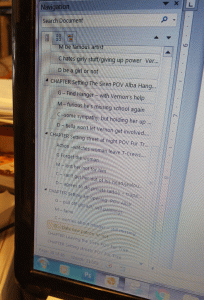Fast Drafting My Way to The End of NaNoWri
What made the difference? Fast drafting.
Fast drafting is the writing process in which you throw out everything you’ve learned about good writing and just write whatever crazy, horrible, wonderful thoughts come spilling out of your head. You don’t stop to do research. You don’t stop to reread. You don’t stop to go back and fix something. You just write. But the question is: How do you know what to write and not end up with a mishmash?
What makes fast drafting work? Good planning at the start and great editing at the end.
Planning for Fast Drafting
I don’t think that I would have been as successful in my first NaNoWri if I hadn’t written the two slow pokes first. I learned a lot about writing between them and all the writing courses I took during those years. For one thing I learned how to plot.
My first two novels are what I would call meandering. Since they were historical fiction, I got buried in the research. I got enamored with writing beautiful settings and long sections of internal thought full of metaphors and literary references. Many chapters existed only to share some of that incredible information I uncovered or to weave in a particular place or quote. Originally these novels topped out at 170,000 words or there about.
Fast Drafting Plot Planning: Stage One ACTION
Now I know that the action must come first. Forget setting. Forget angst. I write a bare-bones sloppy synopsis or what I call a fairy tale version of my novel. I imagine I am sitting around a campfire and making up a fairy tale to entertain a group of antsy kids in the format of first this happened and then that happened and then this and that until bang there’s a horrible villain and a catastrophe and oops a terrible choice that leads to a heroic deed and then an ending – a happy one, of course. I write romance.
Why does this work? The structure of fairy tales is believed by many researchers to be hardwired into our psyches. At least in my case, I know this is true as I grew up on a steady diet of fairy tales, especially Grimms. For a more professional take on this: the this and that and thens are called plot points and there are a ton of wonderful websites and books explaining them. Check out Larry Brook’s StoryFix website, for helpful examples of plot points and story structure, or take Carol Hughes workshop Deep Story I offered this coming April.

Next I take that synopsis, paste into my NaNoWri draft document, and put line breaks between the sentences and label them ACTION. Here is an example from my NaNo draft
- CHAPTER Setting The Siren POV Alba
- ACTION Hanger is missing. Alba goes to The Siren to get help
Fast Drafting Plot Planning: Stage Two GMC
I head each sentence with the word CHAPTER. I identify a possible setting and the POV character. Then the POV character’s goal(s) for that chapter, his or her motivation for achieving that goal, and what’s going to prevent or hinder the character from achieving that goal. Debra Dixon is my resource for this. Here is my GMC from the same chapter:
- Goal– Find Hanger
- Motivation – furious/worried/he could be injured or dead
- Conflict –Alba has gala that night and she must go
Fast Drafting Plot Planning: Stage Three Dilemma
I can’t remember what course I took that made me realize how important the dilemma is in plotting. The dilemma is the hard choice the POV character has to make by the end of the chapter to obtain the goal or at least get closer to it. A dilemma is stated as an either/or choice. It often becomes the hook that leads into the next chapter, especially if the choice is really dangerous or the wrong one. If you have great dilemmas for each chapter, the story will write itself. From the same chapter:
- D – Go to Gala or go look for Hanger
Fast Drafting Plot Planning: Stage Four: Make it Simple
Now here’s the way to put this all together so you can sit down and fast draft. I happen to use Word so I make the CHAPTER ACTION SETTING POV info a Heading 1, and the GMC + D a Heading 2. Now all I have to do is open the FIND Navigation box and there it is – an outline of my novel. This way I can keep the plot right in front of me as I write. I can see where I have been and where I am going.








I wanted to add, that I now include the day number and time of day in the chapter header. Helps me see the overall time span of the action. Very handy.
What an interesting post. I’ve ‘won’ Nano four times and two of the books (the 2nd and 3rd of the Destiny series were written that way.) Like you, I do a ‘bare bones’ synopsis to start with, although it has to be said this can change along the way. I find NaNo is a great way to get the first draft down, but it takes me at least a year to revise that draft until I feel it’s good enough to give to my beta readers or crit partner and then it needs a couple more revisions before I feel it’s fit to be sent to a publisher. Everyone writes the way that is best for them – fast drafting is definitely the best way for me as I’m a procrastinator, and I find NaNo a great motivator, I seem to work best when working to a deadline. If I didn’t use the fast drafting method, I don’t think I’d ever finish another novel- I’d be too busy self editing along the way. For me the ‘internal editor’ needs to be locked away until that first draft is done.
I’m happy you found a way that works for you, Zara. I tried writing like that and it did come out like a mish-mash. Letting it roll like that I found the plot wasn’t working right. It usually takes me about a year for a novel and I can take it in another direction if it isn’t working. I guess everyone has their comfort zone.